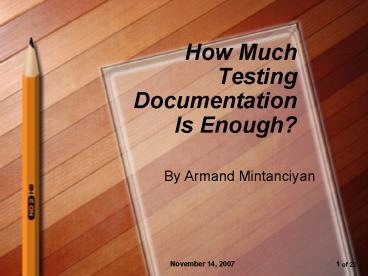How Much Testing Documentation Is Enough - PowerPoint PPT Presentation
1 / 22
Title:
How Much Testing Documentation Is Enough
Description:
... aligned with a typical Systems Development Life Cycle (SDLC) which ... 1. Requirements Analysis: Testing should begin in the requirements phase of the SDLC. ... – PowerPoint PPT presentation
Number of Views:68
Avg rating:3.0/5.0
Title: How Much Testing Documentation Is Enough
1
How Much Testing Documentation Is Enough?
- By Armand Mintanciyan
of 22
2
Introduction
- Software testing is the process used to measure
the quality of developed computer software. - If it is not documented it did not happen.
3
Introduction (continued)
- Computer validation is a requirement for
companies regulated by 21 Code of Federal
Regulations (CFR) Parts 11, 58, 211, 312, 812 and
820. - A validated computerized system is aligned with a
typical Systems Development Life Cycle (SDLC)
which includes concept, requirements, design,
development, test, go-live, maintenance, and
retirement.
4
Tailoring
- Based on the complexity, classification, and
criticality of an application (system) a
methodology can be established to combine and
streamline testing documents (integrated with
risk management). - Complexity
- How many man years a project will take.
- Classification
- Category 1 OS, 2 firmware, 3 COTS, 4
configurable, and 5 customized - Criticality
- Business non-critical, critical, GxP
5
Typical Testing
- Although testing varies between industries and
organizations, a typical cycle to testing - 1. Requirements Analysis Testing should begin in
the requirements phase of the SDLC. - During the design phase, testers work with
developers in determining what aspects of a
design are testable and under what parameter
those tests work.
6
Typical Testing (continued)
- 2. Test Planning Test Strategy, Test Plan(s),
Test Bed creation. - A lot of activities will be carried out during
testing, so that a plan is needed. - 3. Test Development Test Procedures, Test
Scenarios, Test Cases, Test Scripts to use in
testing software.
7
Typical Testing (continued)
- 4. Test Execution Testers execute the software
based on the plans and tests and report any
errors found to the development team. - 5. Test Reporting Once testing is completed,
testers generate metrics and make final reports
on their test effort and whether or not the
software tested is ready for release. - 6. Retesting the defects.
8
Typical Testing (continued)
- A test case (script) is a software testing
document, which consists of event, action, input,
output, expected result, and actual result.
9
Requirements Analysis
- Documentation
- User Requirements Specification (URS)
- Business needs
- Functional Requirements Specification (FRS)
- Intended use
- Vendor Audit Report
10
Test Planning
- Documentation
- Validation Plan (QA Plan)
- Test Types
- Unit
- (individual units of source code are working
properly) - Integration
- (individual software modules are combined and
tested as a group) - User Acceptance
- (confirmation by a business owner that the
software being tested meets agreed upon
requirements) - Systems
- (testing conducted on a complete, integrated
system to evaluate the system's compliance with
its specified requirements) - Validation and Verification
- (Determination of the correctness of the products
of software development with respect to the user
needs and requirements) - Regression
- (Retesting of a previously tested program
following modification to ensure that faults have
not been introduced or uncovered as a result of
the changes made)
11
Test Development
- Design / Build or Configure
- Documentation
- Design Specification
- Test Procedures
- Test Scenarios
- Test Cases
- Test Scripts
- Code Review Checklist
12
Test Development
- Typical Elements in Coding Standards
- Header information
- File naming
- Program description
- Revision record
- Coding style
- Modularity
- Annotation
- Variable definition and equates
- Parameters for interaction
13
Test Execution
- Documentation
- Executed Test Scripts/Test Case from IQ, OQ, PQ
protocols - Instructions
- Expected Results
- Actual Results
14
Test Reporting
- Documentation
- Incident Reports
- Test Summary Reports
- Validation Summary Reports
- Go-Live
- Change Controls
- Periodic Review Report
- Retirement
- Decommissioning Report
15
Objective Evidence
- Documentation
- Screen Shots
- Reports
16
Testing OOS
- eCRF would use reusable components. Instead of
testing every CRF over one would test each
component and perform integration testing on the
components. - Requirement Information
- Information on reusable software products or
components, which describes the functions and
capabilities of the reusable entity. - Information on the reusable entity when
incorporated into new and evolving products.
17
Testing OOS (continued)
- Design Information
- Design information on reusable software products
or components. - Design information on the reusable entity when
the it is incorporated into new and evolving
products.
18
Testing OOS (continued)
- Coding
- Code information on the reusable software conform
to established code management practices. - Testing Information
- Written test information on the reusable software
to show that it was fully tested. - Written test information on the reusable entity
when incorporated into new and evolving products.
- Written test documents for reusable components
contain test cases with defined inputs, defined
outputs, observed results, tester ID, and
recorded errors.
19
Testing SOA
- Service-oriented architecture (SOA) is a strategy
to build software assets in a company using a
service-oriented programming methodology. - Services are software components (e.g. payroll,
asset management), constructed so that they can
be easily linked with other software components.
20
Testing SOA (continued)
- Web services are a linking and communications
methodology. - SOA is an overall IT strategy.
- The testing strategy mentioned previously all
still apply.
21
Automated Testing
- HP Quality Center (formerly Mercury Interactive
Test Director/WinRunner) - manages and governs
quality processes and automates software testing
across an application environment. - Paperless execution screenshots can be attached
to the test case and the test case can be signed
electronically with audit trail.
22
Questions
- To contact Armand Mintanciyan, his e-mail address
is - armand_at_mintanciyan.com































